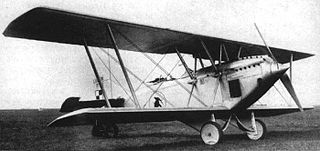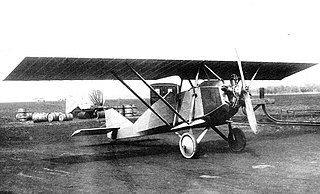
The Focke-Wulf Fw 44 Stieglitz (Goldfinch) is a twin-seat biplane designed and produced by the German aircraft manufacturer Focke-Wulf. It was the company's first major international success.

The Lublin R-VIII was a Polish bomber, reconnaissance aircraft and seaplane designed in the late 1920s by the Plage i Laśkiewicz factory in Lublin. It was the first in-house design of Plage i Laśkiewicz, and the first with the name Lublin.

The Bartel BM.4 was a Polish biplane primary trainer aircraft used from 1929 to 1939 by the Polish Air Force and Polish civilian aviation, manufactured in the Samolot factory in Poznań. It was the first plane of Polish design put into production.

The Bartel BM 5, initially known as M.5 was a Polish biplane advanced trainer used from 1930 to 1939 by the Polish Air Force, manufactured in the Samolot factory in Poznań.

The Bartel BM 6 was a Polish biplane trainer fighter aircraft of 1930. It did not advance beyond the prototype stage.

The Darmstadt D-22 was a sports-plane of Germany, designed and built by Akaflieg of Technische Universität Darmstadt.

The PZL P.1 was a Polish fighter, designed by the engineer Zygmunt Puławski, manufactured by the PZL state-owned factory. It remained a prototype, but it was the first of the Polish PZL gull wing fighter series, leading to the PZL P.7, PZL P.11 and PZL P.24.

The PWS-20 was a Polish single-engine high-wing 8 passenger airliner, built in the PWS factory and when it made its first flight in 1929 it became the first Polish-designed transport aircraft to fly.

The P.W.S.8 was a 1930 Polish sports plane, constructed by the Podlaska Wytwórnia Samolotów (PWS), that remained a prototype.

The RWD 23 was a Polish low-wing trainer aircraft of 1938, constructed by the RWD team, that remained a prototype.

The RWD-16 was a Polish two-seat low-wing sports plane of 1936, constructed by the RWD team, that remained a prototype.

The Lioré et Olivier LéO H-13 was a French biplane two-engine flying boat of the 1920s, built in passenger and military variants.

The PWS-5 or PWS-5t2, was a multi-seated Polish liaison aircraft, developed in 1928 by PWS.

The PWS 3 was a Polish sport aircraft, developed in 1927 by PWS, which remained a prototype.
The Lightwing Type 4 Rooster is an experimental biplane glider, capable of powered or unpowered flight, built in the UK in the 1980s to explore the properties of this unusual glider configuration.

The Dąbrowski D.1 Cykacz (Ticktock) was an unusual, small, low-powered, single-seat biplane, intended to provide wider access to flying. Though it was exceptionally aerodynamically clean, it was under-powered and had limited range. Only one was built.
The Gabriel P 6 was a Polish training aircraft and the P 7 a tourer. The difference between them was the wing configuration, chosen to optimise their speed range for their role, so the P 6 was a biplane and the P 7 a parasol wing aircraft.

The Butler Blackhawk and the Skyway from which it was developed were American three-seat open-cockpit single engine biplanes of the late 1920s that were built in small numbers immediately prior to having their intended production run interrupted by the onset of the Great Depression.

The 1929 Curtiss Model 53 Condor, also known as the Curtiss Model 53 Condor 18 or the Curtiss CO Condor, was a civil passenger version of the Model 52 Condor bomber. A twin-engined biplane, it carried 18 passengers.

The Wiley Post Model A is a U.S. two seat sports biplane, built in small numbers in the 1930s.



















